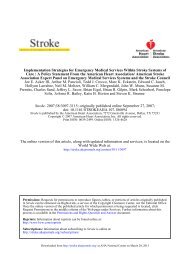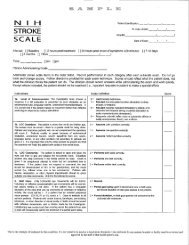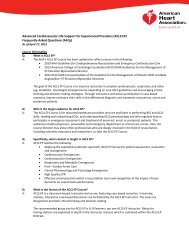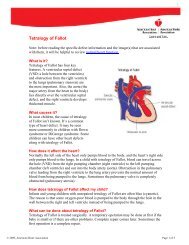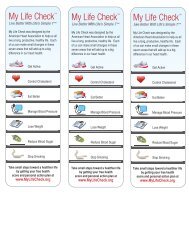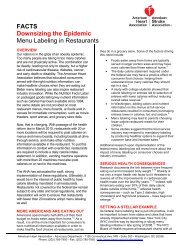12-Lead ECG and STEMI Basics
12-Lead ECG and STEMI Basics
12-Lead ECG and STEMI Basics
Create successful ePaper yourself
Turn your PDF publications into a flip-book with our unique Google optimized e-Paper software.
<strong>12</strong>-<strong>Lead</strong> <strong>ECG</strong> <strong>and</strong><br />
<strong>STEMI</strong> <strong>Basics</strong>
Disclosure Statement<br />
• Tom Bouthillet, NREMT-P<br />
• Captain, Town of Hilton Head Isl<strong>and</strong>,<br />
South Carolina, Fire & Rescue Division<br />
• <strong>12</strong>-<strong>Lead</strong> <strong>ECG</strong> <strong>and</strong> <strong>STEMI</strong> <strong>Basics</strong><br />
• Speakers Bureau, Physio-Control<br />
• No off-label drug uses<br />
• No relevant financial relationships to<br />
disclose
Time is therapy for<br />
<strong>STEMI</strong> patients!
N Engl J Med 2007;357:1631-1638<br />
Significant increase in mortality for<br />
every 15 minutes of delay!
Who should get a<br />
<strong>12</strong>-lead <strong>ECG</strong>?
All of these complaints warrant a<br />
<strong>12</strong>-lead <strong>ECG</strong>!<br />
• Chest pain<br />
• Atypical chest pain<br />
• Epigastric pain<br />
• Back, neck, jaw, or arm pain without chest pain<br />
• Palpitations<br />
• Syncope or near syncope<br />
• Pulmonary edema<br />
• Exertional dyspnea<br />
• Weakness<br />
• Diaphoresis unexplained by ambient temperature<br />
• Feeling of anxiety or impending doom<br />
• Suspected diabetic ketoacidosis
What about cardiac arrest<br />
patients with ROSC?<br />
• Also include patients who are<br />
successfully resuscitated from cardiac<br />
arrest!
This patient was observed to collapse from sudden cardiac arrest. The<br />
initial rhythm was ventricular fibrillation. After 2 shocks <strong>and</strong> minimally<br />
interrupted chest compressions the patient experienced return of<br />
spontaneous circulation (ROSC)
The post-arrest <strong>12</strong>-lead <strong>ECG</strong> showed acute inferior <strong>STEMI</strong>. It was<br />
immediately transmitted to the hospital.
How about flu-like symptoms?
For example<br />
• A 66 year old female complains of nausea<br />
<strong>and</strong> vomiting<br />
• She’s certain that she has the flu!<br />
• When questioned, she admits to having<br />
mild chest discomfort on <strong>and</strong> off for the<br />
last 2 days
The 3-lead <strong>ECG</strong> looks good…
The <strong>12</strong>-lead <strong>ECG</strong> can wait until<br />
the patient is loaded in the back<br />
of the ambulance!
Right?
Wrong!
The old concept<br />
“Put the patient on<br />
the monitor.”
The new concept<br />
“Obtain a <strong>12</strong>-lead<br />
<strong>ECG</strong>!”
When?<br />
• With the first set of vital signs <strong>and</strong> before<br />
oxygen <strong>and</strong> nitroglycerin (unless the<br />
patient is in respiratory distress or the<br />
room air SpO2 < 94)<br />
• Ideally, the <strong>12</strong>-lead <strong>ECG</strong> should be<br />
captured within 10 minutes of making<br />
patient contact (the “at patient” time)
Where?<br />
• On the scene, prior to relocating the<br />
patient to the ambulance (unless it is<br />
absolutely necessary to protect the<br />
patient’s dignity)
How?<br />
• Whenever possible undress patients from<br />
the waist-up!<br />
• For female patients, this can include the<br />
bra but protect the patient’s modesty <strong>and</strong><br />
dignity<br />
• Alert <strong>and</strong> cooperative patients can remove<br />
their own bra if you hold up a towel or<br />
sheet to give them some privacy<br />
• It’s easier to place electrodes <strong>and</strong> it’s the<br />
only way to perform a physical exam!
How?<br />
• The proper way to move a patient’s breast<br />
out of the way is with the back of a gloved<br />
h<strong>and</strong><br />
• You can also have patients lift up their<br />
own breast<br />
• Tip: Obtain gowns from the emergency<br />
department so that patients can be<br />
covered up after the electrodes are placed
Skin Prep<br />
• The chest hair should be removed with the<br />
electric clippers if possible<br />
• If the patient is diaphoretic, wipe off the<br />
skin!<br />
• Benzoin tincture works great! But it’s also<br />
flammable so don’t defibrillate over it.
<strong>Lead</strong> Placement<br />
• The limb leads go on the limbs<br />
• The white <strong>and</strong> black electrodes can be<br />
placed on the center of the muscle<br />
mass of the deltoids (which leaves room<br />
for the BP cuff)<br />
• The red <strong>and</strong> green electrodes can be<br />
placed on the quadriceps (or a nonbony<br />
<strong>and</strong> non-hairy part of the leg)
RA<br />
LA<br />
RA = Right Arm<br />
LA = Left Arm<br />
RL = Right Leg<br />
LL = Left Leg<br />
RA<br />
LA<br />
RL<br />
LL<br />
RL<br />
LL<br />
RA - White<br />
LA - Black<br />
RL - Green<br />
LL - Red
<strong>Lead</strong> Placement<br />
• When placing the precordial leads, keep<br />
the edges of the electrodes lined up! It will<br />
help keep you organized!
V6<br />
V5<br />
V1<br />
V2<br />
V3<br />
V4
Common Mistakes<br />
• The limb leads are placed on the chest!<br />
• <strong>Lead</strong>s V1 <strong>and</strong> V2 are placed one or two<br />
intercostal space too high on the chest (or<br />
even higher)<br />
• <strong>Lead</strong>s V1 <strong>and</strong> V2 are placed too far apart<br />
(if you make a “peace sign” you should be<br />
able to touch both electrodes)<br />
• <strong>Lead</strong> V3 is placed directly beneath lead V2<br />
• <strong>Lead</strong> V4 is under the nipple instead of the<br />
midclavicular line
Tips for achieving excellent<br />
data quality<br />
• Str<strong>and</strong> each lead out individually!<br />
• When the <strong>ECG</strong> leads are wrapped around<br />
each other, or wrapped around the IV line,<br />
the O2 tubing, or the BP tubing, it can<br />
increase artifact!<br />
• Make sure the patient isn’t “twiddling” the<br />
leads
Tips for achieving excellent<br />
data quality<br />
• Make sure the patient is resting in a semi-<br />
Fowler’s position <strong>and</strong> breathing normally<br />
• The patient should not be propping him or<br />
herself up with his or her arms<br />
• This can be transmitted into the <strong>12</strong>-lead<br />
<strong>ECG</strong> is muscle tremor artifact
Tips for achieving excellent<br />
data quality<br />
• If the patient is shivering, lay a sheet,<br />
towel, or blanket over the patient prior to<br />
capturing the <strong>12</strong>-lead <strong>ECG</strong><br />
• This can also help minimize<br />
Parkinsonian muscle tremors
This <strong>12</strong>-lead <strong>ECG</strong> was obtained from a firefighter during<br />
training at the fire station. It was cold at the station (they don’t<br />
call it the “Ice House” for nothing) <strong>and</strong> you can see muscle<br />
tremor artifact in the <strong>ECG</strong>.
The second <strong>12</strong>-lead <strong>ECG</strong> was captured after placing a single<br />
towel over the firefighter. What a difference!
Tips for achieving excellent<br />
data quality<br />
• For some patients, it’s very difficult to get a<br />
clean tracing (e.g., acute respiratory<br />
distress, very diaphoretic patients)<br />
• However, in most cases it’s possible to<br />
obtain a <strong>12</strong>-lead <strong>ECG</strong> with excellent, or at<br />
least acceptable data quality<br />
• It takes the desire to obtain a clean <strong>12</strong>-<br />
lead <strong>ECG</strong> <strong>and</strong> the knowledge to<br />
troubleshoot problems
Okay, I’ve got my <strong>12</strong>-lead <strong>ECG</strong>…
Now what?
Sample <strong>STEMI</strong> Alert Protocol<br />
• Hilton Head Isl<strong>and</strong> Fire & Rescue<br />
• This protocol does an excellent job<br />
identifying patients with acute <strong>STEMI</strong><br />
• All protocols must have buy-in from the<br />
stakeholders in the system of care!<br />
• “If you’ve seen one EMS system, you’ve<br />
seen one EMS system”<br />
• There is more than one way to do this!
Patient has signs <strong>and</strong> symptoms of ACS<br />
<strong>12</strong> lead <strong>ECG</strong> shows excellent data quality<br />
Computer reads ***ACUTE MI SUSPECTED***<br />
QRS duration is < <strong>12</strong>0 ms (0.<strong>12</strong> s)<br />
Paramedic agrees with computer interpretation<br />
<strong>ECG</strong> shows 1 mm of ST-segment elevation in 2 or<br />
more contiguous leads (2 mm in leads V2 or V3)<br />
Reciprocal changes are present<br />
Contact dispatch <strong>and</strong> announce “<strong>STEMI</strong> Alert”<br />
Transmit the <strong>ECG</strong> to the emergency department
Step 1<br />
• Is the patient showing signs <strong>and</strong> symptoms<br />
of an acute coronary syndrome (ACS)?<br />
• This is usually (but not always) chest pain<br />
• If yes, then move on to Step 2
Step 2<br />
• Have I obtained a <strong>12</strong>-lead <strong>ECG</strong> with<br />
excellent data quality?<br />
• This is an extremely important step!<br />
• Poor data quality confounds computer<br />
measurements <strong>and</strong> causes interpretive<br />
algorithm to give inaccurate readings!<br />
• Poor data quality makes subtle<br />
interpretation of ST-segments difficult or<br />
sometimes impossible
Step 2<br />
• If you’re having trouble obtaining a high<br />
quality <strong>12</strong>-lead <strong>ECG</strong>, stop <strong>and</strong> correct the<br />
problem!<br />
• Don’t just say, “We’ve got to go!”<br />
• Troubleshooting the problem is time well<br />
spent!<br />
• I have seen reperfusion delayed because<br />
of poor data quality<br />
• I have seen patients cathed because of<br />
poor data quality!
Here poor data quality is triggering the ***ACUTE MI SUSPECTED***<br />
message. This message has a high specificity for acute <strong>STEMI</strong>, but only<br />
when the patient has signs <strong>and</strong> symptoms of ACS <strong>and</strong> the data quality is<br />
excellent! The <strong>STEMI</strong> Alert should not be called from the field based on<br />
this <strong>12</strong>-lead <strong>ECG</strong>.
Here the data quality is good, but flutter waves are triggering the<br />
***ACUTE MI SUSPECTED*** message. A <strong>STEMI</strong> Alert should not be<br />
called from the field. Note: False positive messages are more common<br />
with tachycardias.
Here the data quality is good, but it’s a wide complex tachycardia (paced<br />
rhythm as evidenced by pacer spikes in leads V4, V5, <strong>and</strong> V6). This <strong>ECG</strong><br />
was captured on an interfacility transport. The patient was unconscious<br />
<strong>and</strong> intubated, en route to neurosurgery. Question: Were “signs <strong>and</strong><br />
symptoms of ACS” present?
Step 3<br />
• Either the computerized interpretation<br />
reads ***ACUTE MI SUSPECTED *** <strong>and</strong><br />
the paramedic agrees with the<br />
computerized interpretation….<br />
• Or the QRS duration is < 0.<strong>12</strong> s, STsegment<br />
elevation is present in 2 or more<br />
contiguous leads, <strong>and</strong> reciprocal changes<br />
are present
Patient has signs <strong>and</strong> symptoms of ACS<br />
<strong>12</strong> lead <strong>ECG</strong> shows excellent data quality<br />
Computer reads ***ACUTE MI SUSPECTED***<br />
QRS duration is < <strong>12</strong>0 ms (0.<strong>12</strong> s)<br />
Paramedic agrees with computer interpretation<br />
<strong>ECG</strong> shows 1 mm of ST-segment elevation in 2 or<br />
more contiguous leads (2 mm in leads V2 or V3)<br />
Reciprocal changes are present<br />
Contact dispatch <strong>and</strong> announce “<strong>STEMI</strong> Alert”<br />
Transmit the <strong>ECG</strong> to the emergency department
In this example the interpretive algorithm is giving the ***ACUTE MI<br />
SUSPECTED*** message but the <strong>ECG</strong> is showing no signs of acute injury.<br />
The <strong>STEMI</strong> Alert should not be called from the field. Note: The inverted P-<br />
waves in the inferior leads artificially depressed the baseline which made the<br />
computer think the ST-segments were elevated.
In this example, the <strong>12</strong>-lead <strong>ECG</strong> shows an obvious <strong>STEMI</strong>, but for some<br />
reason the data quality prohibits a computerized interpretation <strong>and</strong> no<br />
reciprocal changes are present. What should you do?
Answer: Correct the problem <strong>and</strong> obtain an additional <strong>12</strong>-lead <strong>ECG</strong>. Now<br />
the data quality is acceptable, the interpretive algorithm says ***ACUTE<br />
MI SUSPECTED*** <strong>and</strong> the paramedic agrees with the computerized<br />
interpretation. This is the <strong>ECG</strong> that should be transmitted to the<br />
emergency department.
For this borderline case found on the LIFENET it is questionable as to<br />
whether or not 2 mm of ST-segment elevation are present in leads V2<br />
<strong>and</strong> V3. However, reciprocal changes appear to be present in leads III<br />
<strong>and</strong> aVF. What should the treating paramedic do?
Answer: Perform serial <strong>ECG</strong>s! Less than 5 minutes later, this evolving <strong>STEMI</strong><br />
triggers the ***ACUTE MI SUSPECTED*** message.
In this example, the interpretive algorithm isn’t giving the ***ACUTE MI<br />
SUSPECTED*** message even though hyperacute T-waves are evident in<br />
leads V2 <strong>and</strong> V3 <strong>and</strong> reciprocal changes are present in leads III <strong>and</strong> aVF.<br />
Remember, it’s just a computer! It doesn’t know when to ignore the rules. So<br />
what should the treating paramedic do?
Answer: Either call the <strong>STEMI</strong> Alert based on the hyperacute T-waves <strong>and</strong><br />
reciprocal changes or perform serial <strong>ECG</strong>s! Less than 5 minutes later the<br />
interpretive algorithm is giving the ***ACUTE MI SUSPECTED*** message.
The vast majority of the time,<br />
calling a Code <strong>STEMI</strong> should<br />
be a simple decision!
Interpretive statement says ***ACUTE MI SUSPECTED***<br />
Reciprocal changes<br />
ST-segment elevation suggestive of<br />
acute injury
<strong>STEMI</strong> Recognition<br />
• Check out the free webinar “<strong>STEMI</strong><br />
Recognition: Beyond the <strong>Basics</strong>” online<br />
at EMS World
Normal <strong>ECG</strong>
V6<br />
V5<br />
V4<br />
V1<br />
V2<br />
V3
V9<br />
V8<br />
V7<br />
V6<br />
V5<br />
V4R<br />
V4<br />
V1<br />
V2<br />
V3
What is a Reciprocal Change?
II<br />
I
Upwardly Concave<br />
Upwardly Convex<br />
(or “straight” or “non-concave”)
Inferior <strong>STEMI</strong>
Inferior <strong>STEMI</strong>
Inferior <strong>STEMI</strong>
Inferior <strong>STEMI</strong>
HR 68<br />
PR 188<br />
QRS 104<br />
P-R-T 84 84 106
V6<br />
V4R<br />
V1<br />
V2<br />
V3<br />
V5
HR 65<br />
PR 190<br />
QRS 102<br />
P-R-T 84 76 107 V4R
HR 80<br />
PR 204<br />
QRS 113<br />
P-R-T 69 84 111
Anterior <strong>STEMI</strong>
Anterior <strong>STEMI</strong>
Anterior <strong>STEMI</strong>
Anterior <strong>STEMI</strong>
Lateral <strong>STEMI</strong>
Lateral <strong>STEMI</strong>
Lateral <strong>STEMI</strong>
Lateral <strong>STEMI</strong>
Posterior <strong>STEMI</strong>
Posterior <strong>STEMI</strong>
BMJ 2002; 324:831-834
Posterior <strong>STEMI</strong>
Posterior <strong>STEMI</strong>
Posterior <strong>STEMI</strong>
Tom Bouthillet<br />
• Email: ems<strong>12</strong>lead@gmail.com<br />
• Phone: 843-247-3453 (cell)<br />
• Website: ems<strong>12</strong>lead.com<br />
• Facebook: facebook.com/ems<strong>12</strong>lead<br />
• Twitter: @tbouthillet / @EMS<strong>12</strong><strong>Lead</strong>



